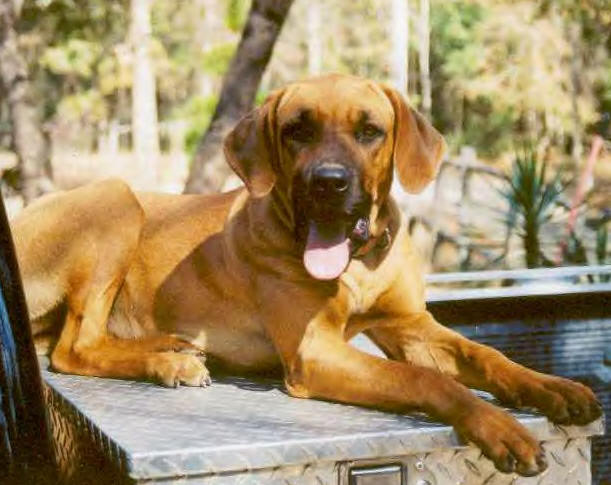
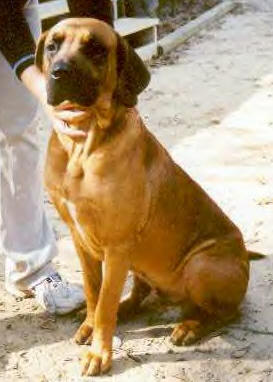
Sand Ridge Kennels
The Howard family has spent at over one hundred years developing their line of Black Mouth Curs to today’s level.
The history of Howardtown indicates in 1875, a cur dog was being used on cattle, goats, sheep, and hogs during the day and for hunting at night on various animals. They were used on trap lines and squirrels. These were dogs that lived and worked in the woods. It was expected / required that a dog perform on his own. "If it required two dogs to work cattle or catch a hog, you replaced them with one dog that earned its keep."
Howardtown is located in Washington County, Alabama, with Chatom being the county seat. In the past, Black Mouth Curs and other breeds of Washington County were recorded at the county seat, the same as earmarks on hogs and brands on cattle. Dogs were stolen back then and it appears this record helped to establish ownership.
Mr. J.D. Howard (JD), as have many Howard ancestors, continues to breed for performance, selecting only the very best for breeding and culling the rest. He will not breed or keep a dog that is vicious or has a bad temperament. J.D. demands that his dogs have the mental capacity for learning. He believes that dogs must be trained/worked. They cannot prove their worth on a chain or in a pen. Some good, well-bred dogs have failed one owner because they were not trained/taught or given a chance, yet proved their worth when purchased by a second owner. Without practice, a dog cannot be expected to perform at peak level.
The Howards knew, down through the ages, the traits they desired in their Black Mouth Cur and stayed focused on their breeding program. The Howard’s strict breeding practices has resulted in a fault-free, breed true, family line that reproduces with hunting ability (hogs, squirrels, cattle, coons, and coyote), conformation, color (most are reddish-golden to red, with a black mask), excellent coat, and good temperament.


As a result, folks in this area feel the Howard dogs are the best available and serve their hunting needs for various types of game and work on the farm. Although he does not advertise except by word-of-mouth local hunters (in a 300 to 400 mile area) are very confident that a good hunting dog will come from the Howard line and pups are in great demand when available. His objective in breeding is to raise the standard of the Black Mouth Cur and provide a better dog for himself, his family and his friends.
From the next generation of Howards, Steve Howard is stepping forward to take the challenge of continuing the Howard tradition of breeding outstanding working dogs. With JD’s knowledge and help, Steve will be successful.
Description of the Howard line of Black Mouth Cur
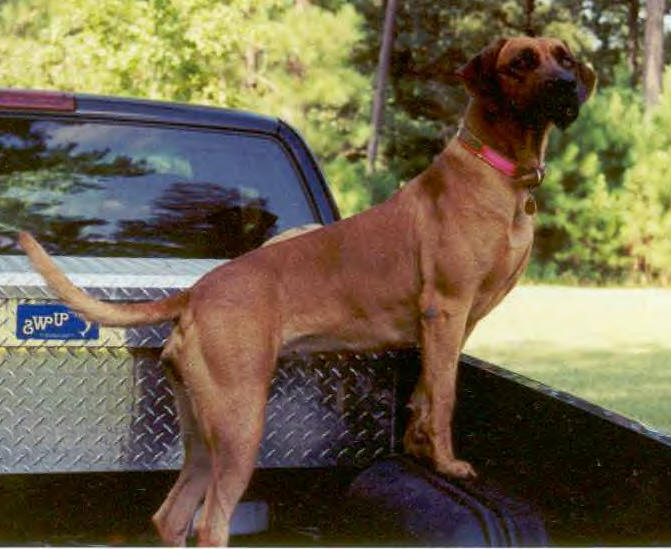 The black mouth that we go by on the dogs we own happens to be on the inside
roof of the mouth and not the black mask that appears on some of the dogs. It is
nice cosmetics as far as appearance but most of my dogs have a light to medium
black mask on the face and some do not have any black at all.
The black mouth that we go by on the dogs we own happens to be on the inside
roof of the mouth and not the black mask that appears on some of the dogs. It is
nice cosmetics as far as appearance but most of my dogs have a light to medium
black mask on the face and some do not have any black at all.
Another interesting feature is the different color spectrum they have. They
can range in color from a light red to medium to a cold hard red, and varying
shades of what we call yellow from a light pale yellow to dark yellow. Every
once in a blue moon we will even throw a solid white pup. The old folks from
where I am from always said that the litter of pups that comes with the white
cur will be an outstanding litter. I have seen this happen. Although most of the
elders
are essentially deceased
that knew and owned the dogs from where I am from, there are some still around that can tell you of some of the exploits
of the "white cur".
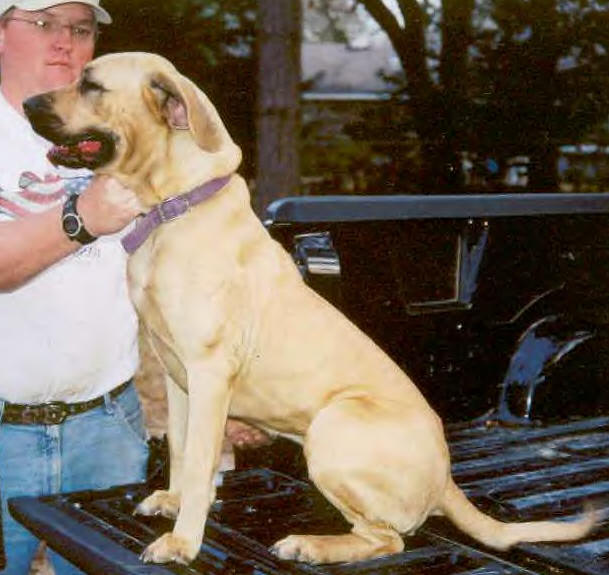 While I am on the subject, I never have had brindle curs or saddle backs in
my line of dogs nor have I ever had a solid black cur that seems to be popping
up a lot in my part of the country in present days. I do a lot of bay pen
competitions and see dogs that folks call "Blackmouth Curs" and they may be big
as a Rottweiller with hair long as a collie. This doesn’t happen in my dogs.
They are all shorthaired with the color shades I mentioned earlier.
While I am on the subject, I never have had brindle curs or saddle backs in
my line of dogs nor have I ever had a solid black cur that seems to be popping
up a lot in my part of the country in present days. I do a lot of bay pen
competitions and see dogs that folks call "Blackmouth Curs" and they may be big
as a Rottweiller with hair long as a collie. This doesn’t happen in my dogs.
They are all shorthaired with the color shades I mentioned earlier.
If you have ever seen the movie "Little Big Man" with Dustin Hoffman you will
notice that in a few scenes while out on the plains there are dogs running with
the Indians. These dogs are very much similar in appearance to some of the Black
Mouth Curs that are around today...
Some lines of BMCs have the inherent trait of being bobtailed. This is not
the case in my line of dogs. While I have crossed over with bobtailed curs of
another line before, I did not like this trait and kept none of the offspring
and it does not show up in my line at all. The only time you will see bobtail in
my line is due to some type of trauma in which the tail had to be amputated. I
prefer long tails because it is my belief that it helps with the balance of the
dog while working in confined quarters. Bulldog folks will put me down on this
one but keep in mind the bulldogs job is to catch. He does not rationalize just
catches. A good BMC will learn from his mistakes and generally will not make the
same mistake twice. If he doesn’t learn, he generally gets gored consistently or
killed early in life.
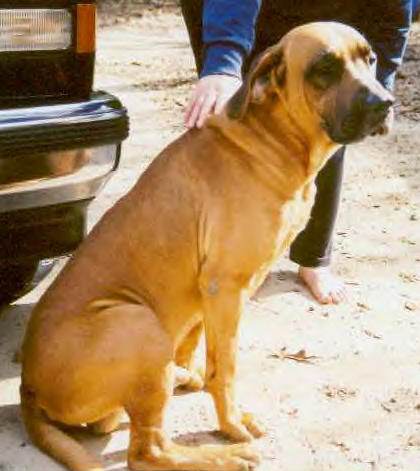 Ring necks are generally considered culls because most folks desire to have a
solid color, although some of my folks have had ring necks that made awesome
dogs. Color wasn’t a factor, a working dog was. My cousin JD Howard, who by the
way is a much more knowledgeable source on these dogs than myself, will tell you
that. Thing is, if you want to talk to JD you will have to drive to his place,
get ready to drink several pots of coffee, and make sure you have plenty of pen
and paper.
Ring necks are generally considered culls because most folks desire to have a
solid color, although some of my folks have had ring necks that made awesome
dogs. Color wasn’t a factor, a working dog was. My cousin JD Howard, who by the
way is a much more knowledgeable source on these dogs than myself, will tell you
that. Thing is, if you want to talk to JD you will have to drive to his place,
get ready to drink several pots of coffee, and make sure you have plenty of pen
and paper.
For folks just starting out with BMCs, if their primary purpose is gonna be a "just around the house dog" especially for family protection I would recommend a female and not the male. If I were selecting primarily for hunting I would want a male.
If a Black Mouth takes a notion to wander, it is generally the males; they will jump a fence or dig out. I have seen them climb 10-foot kennel fences if it wasn’t roofed to get out to go roam or to get in to a female in heat.
They are easy to train and will pick up a winter coat that thins out during the spring/summer months and are always a shorthaired dog.
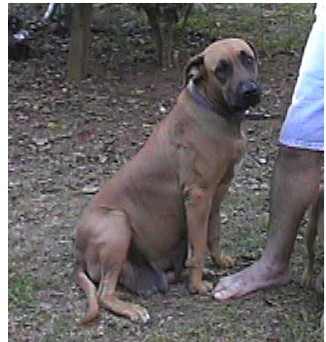
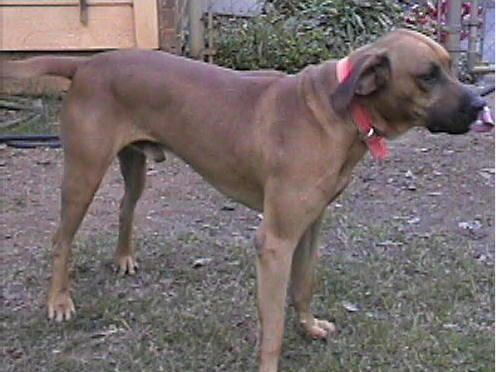
Here are pictures of my male and female. Rox-e is the female on the right. I still have her. I will breed her one more time and retire her to "just good ole livin" because she has surely earned her keep here.
My females generally go just below the knee and the males striking at the knee or even taller. The females go between 65 to 75 lbs. while most of my males go 70+ lbs. They are a larger strain than most BMCs.
Some of the more well known names that show up on the Howard and related lines are Rock (JD Howard), Bucket (Ricky Perkins but out of Howard Line), (Busbys Red), and (Penny, Red Dog, Jake, Tinker, Scout, and Rox-e) all of which are Howard BMCs. There are many more.
Pups are $250 up and I do ship. Buyer pays all incurred costs of vet certification, shipping crate, and airline costs.
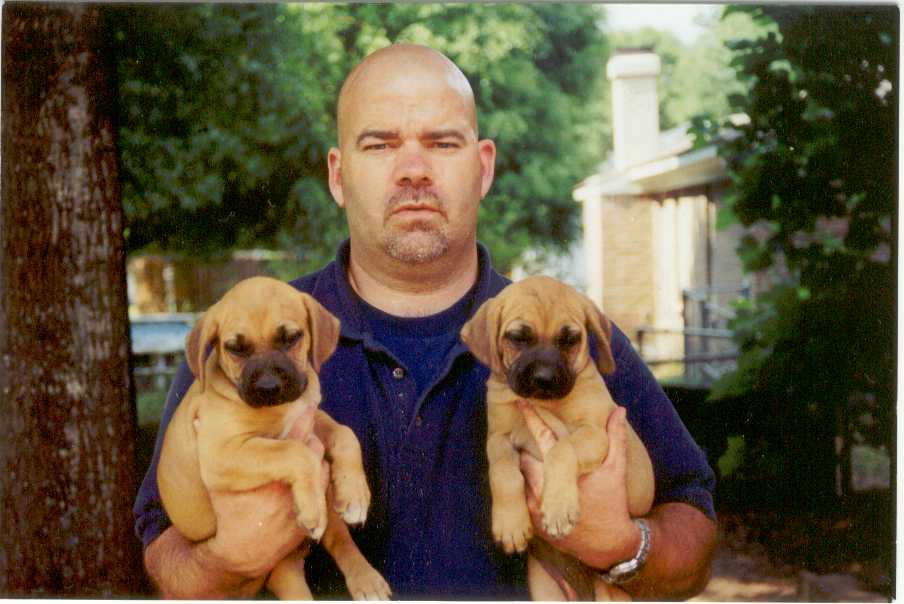
Here are two of my pups at 7 weeks of age. I kept the dog on the right and the
one on the left went to Palm Beach, Florida. The big ugly dog in the middle is
none other than me.
Thank you for stopping by and viewing my webpage.
For further information, I can be contacted at;